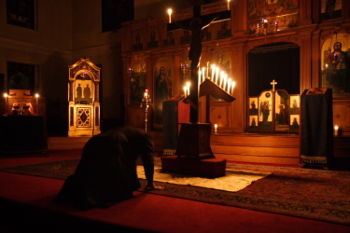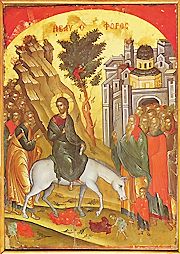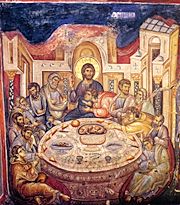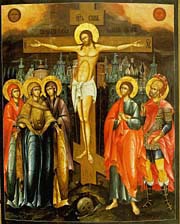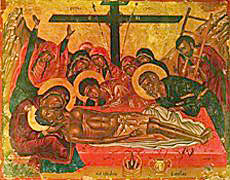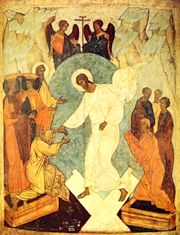Semaine Sainte : Différence entre versions
(→Holy Monday) |
(→Le Lundi Saint) |
||
| Ligne 15 : | Ligne 15 : | ||
Les premiers trois jours de la Semaine Sainte nous rappelle les dernières instructions du Christ à ses disciples. On rappelle ces enseignements durant la célébration des offices des Grandes [[Complies]], des Matines, des [[Heures]], et de la [[Liturgie]]. La [[Liturgie des Dons Présanctifiés]] célébrée pendant ces jours comprend des lectures tirées de l' [[Exode]], du [[Livre de Job |Job]], et de l'[[Evangile de Matthieu |Matthieu]]. | Les premiers trois jours de la Semaine Sainte nous rappelle les dernières instructions du Christ à ses disciples. On rappelle ces enseignements durant la célébration des offices des Grandes [[Complies]], des Matines, des [[Heures]], et de la [[Liturgie]]. La [[Liturgie des Dons Présanctifiés]] célébrée pendant ces jours comprend des lectures tirées de l' [[Exode]], du [[Livre de Job |Job]], et de l'[[Evangile de Matthieu |Matthieu]]. | ||
| − | + | L'office des Matines célébré les soirs du dimanche des Rameaux, du Lundi Saint et du Mardi Saint, anticipe les événements du jour suivant et partage même un thème. Ces offices de [[l'Epoux]] découlent de la parabole des dix Vierges,qui demande que l'on se prépare pour le Second Avènement, car "le voleur vient au milieu de la nuit" (Matt. 26:1-13) | |
===Holy Wednesday=== | ===Holy Wednesday=== | ||
Version du 17 avril 2008 à 20:24
| Cet article (ou bien des fragments) est proposé pour être traduit en français!
Si vous désirez assumer la traduction (partiellement ou intégralement), annoncez svp cela dans la page de discussions de l'article. |
La Semaine Sainte est la semaine qui, à la conclusion du Grand Carême, suit le Samedi de Lazare, jusqu'à la célébration de la Pâques.
Sommaire
Histoire
La célébration de la Semaine Sainte remonte aux premiers temps de l'Eglise Primitive. Au IVe siècle, elle avait déjà trouvée sa forme, assez proche, semble-t-il, de celle que nous connaissons aujourd'hui. Un pélerin de Jérusalem- Égérie - de la fin du IVe siècle, a fait le récit du déroulement de la semaine suivant les offices de la résurrection de Lazare, " ... la semaine de Pâques, qu'ils appellent ici, Semaine Sainte", notant la procession qui commémore l'entrée triomphale du Christ à Jérusalem le premier jour de la semaine. C'est pendant cette semaine que nous nous remémorons la Passion du Christ et Sa Crucifixion.
La Semaine Sainte
Le samedi de Lazare met fin au Grand Carême. Cette célébration commémore le réveil d'entre les morts de Lazare et la promesse de la résurrection universelle pour tous. Le samedi de Lazare est un pont vers la Semaine Sainte durant laquelle l'Eglise se remémore les derniers jours du Christ avant Sa Crucifixion et Sa Résurrection, Sa passion. Pendant cette semaine les matines Matins du jour sont célébrées la veille, et les vêpres le matin même. Cette anticipation des offices donne au fidèle l'impression que le monde est en labeur, sens dessus-dessous, à cause de la passion que notre Seigneur a enduré pour notre salut. Bien que cette pratique soit inhabituelle, elle est canonique et correspond à la définition biblique selon laquelle le jour commence au coucher du soleil.Le dimanche des Rameaux
Le premier jour de la Semaine Sainte commence avec les vêpres Vespers du samedi soir qui conduisent le lendemain matin, dimanche, à la célébration de "l'Entrée de notre Seigneur à Jérusalem", appelé en Occident, "le dimanche des Rameaux" Palm Sunday. As Christ makes his triumphal entry into Jerusalem, his divine kingdom on Earth is proclaimed under the branches of the palm tree.
Le Lundi Saint
Les premiers trois jours de la Semaine Sainte nous rappelle les dernières instructions du Christ à ses disciples. On rappelle ces enseignements durant la célébration des offices des Grandes Complies, des Matines, des Heures, et de la Liturgie. La Liturgie des Dons Présanctifiés célébrée pendant ces jours comprend des lectures tirées de l' Exode, du Job, et de l'Matthieu.
L'office des Matines célébré les soirs du dimanche des Rameaux, du Lundi Saint et du Mardi Saint, anticipe les événements du jour suivant et partage même un thème. Ces offices de l'Epoux découlent de la parabole des dix Vierges,qui demande que l'on se prépare pour le Second Avènement, car "le voleur vient au milieu de la nuit" (Matt. 26:1-13)
Holy Wednesday
Within the past two centuries, Byzantine practice has developed to include the mystery of Holy Unction, which is celebrated on Holy Wednesday, commemorating Christ's anointing with myrrh. The service ends with the priest anointing the faithful with holy oil. Some jurisdictions outside the Byzantine world also include this practice, such as in some parts of the OCA.
The services appointed by the Typikon for the evening of Holy Wednesday recall that on this day Judas betrayed Christ, which led to the tradition from Apostolic times of fasting on Wednesday throughout the year. It also focuses on the Mystical Supper, which is celebrated in the liturgy of the following day.
Holy Thursday
Holy Thursday begins with the celebration of vespers and the Divine Liturgy of St. Basil with a Reserved Eucharist in representation of the earthly presence of Christ realized at the Last Supper. In the evening, anticipating the Matins of Friday morning, the Holy Passion service of the reading of the Twelve Gospels is conducted. In these readings Christ's last instructions to his disciples are presented, as well as the prophecy of the drama of the Cross, Christ's prayer, and his new commandment. The twelve readings are:
- John 13:31-18:1
- John 18:1-29
- Matthew 26:57-75
- John 18:28–19:16
- Matthew 27:3-32
- Mark 15:16-32
- Matthew 27:33-54
- Luke 23:32-49
- John 19:19-37
- Mark 15:43-47
- John 19:38-42
- Matthew 27:62-66
Holy Friday
Great and Holy Friday begins with reading of the Royal Hours leading up to Vespers of Friday afternoon, at which time the removal of the Body of Christ from the Cross is commemorated. The priest removes the Body of Christ, the Epitaphios, from the Cross, wraps it in a white cloth and carries it into the altar. In an evening service, called the Lamentations at the Tomb, the priest carries the Epitaphios, the painted or embroidered cloth representation of Christ, from the altar around the church before placing it in the Sepulcher, a bier symbolizing the Tomb of Christ. This procession, with the faithful carrying lighted candles, represents Christ's descent into Hades.
Holy Saturday
Great and Holy Saturday Vespers and a Divine Liturgy of St. Basil are served, marked with readings of Psalms and Resurrection hymns that tell of Christ's descent into Hades, celebrated as the "First Resurrection" of Adam and the conquering of Death. It is appointed by the typikon to be celebrated in the afternoon, though it is served in the morning in many places.
This service comes from the ancient liturgical tradition of the Church of Constantinople and was its primary Paschal service. The hymn "Arise O God" from the Psalms was the original primary Paschal hymn before "Christ is risen" came to take its place. Its place as the ancient Constantinopolitan Paschal celebration is what gives the service such a bright and resurrectional character.
Pascha
- Main article: Pascha
Pascha, the Feast of Feasts, celebrations begins just before midnight with the singing of the Odes of Lamentation as the Resurrection Vespers begins with the church in complete darkness. As midnight approaches the priest taking a light from a vigil light within the altar passes the flame to the faithful for their candles while singing "Come ye and receive light from the unwaning life, and, glorify Christ, who arose from the dead." Then the priest leads the faithful out of the church in procession. After circling the church either one or three times, as the procession nears the entrance door of the church, the priest leads in the singing of the hymn of Resurrection. "Christ has risen from the dead, by death trampling upon Death, and has bestowed life upon those in the tombs!" At this point the priest and faithful enter the well-lighted church for the remaining part of Vespers and the breaking of the fast with the Divine Liturgy. After conclusion of the Divine Liturgy, in many communities, the faithful retire to an agape meal to break the Fast together, and then return home as dawn arrives. Later in the day of Pascha the faithful again gather for prayer with lighted candles in a vespers service, singing the hymn "Christ is Risen from the Dead," and greeting each other joyously, "Christ is risen" and responding with, "Truly He is risen."
Local customs
Jerusalem
- The Orthodox Patriarch breaks the seal of the door of the tomb of Christ in the Church of the Holy Sepulchre and emerges with the Holy Fire.
Greece
- Painting of the red eggs
- Preparation of sweets ("Koulouria")
- The Holy Fire is flown from Jerusalem on Olympic Airways, accompanied by high-ranking Greek Orthodox priests and government officials to the Athens airport. The Holy Flame is met with a reception of honour guards and is taken to the small church of Agioi Anargyroi in the Plaka square.
- On Sunday, all over Greece, the Greek people will hold very festive celebrations. Traditionally, lambs are roasted (which symbolise Christ), and friends and family get together to eat, drink, talk and dance.
In some towns, this tradition is a community celebration. For example:
- In Arachova, rows of lambs are roasted in the village square.
- On some islands, the town shoots "Judas"
External links
- A Liturgical Explanation for the Days of Holy Week, by Fr. Alexander Schmemann
- The Historical Development of Holy Week Services In the Orthodox/Byzantine Rite, by Fr. Nabil L. Hanna
- Holy Week GOARCH
- The Origins of Pascha and Great Week - Part I
- The Origins of Pascha and Great Week - Part II
- Holy Week and Pascha
- Holy Week
- Approach to Holy Week
